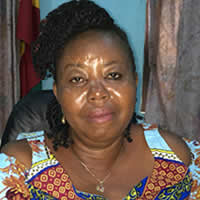

The Municipality is located within longitudes 1°5W and 1°39’ W and latitudes 7°9’ N and 7°36’N. It has a large land size of about 1,782.2sq.km. (690.781sq.miles) and is the fifth largest in Ashanti region’s 21 districts. It constitutes about 7.3% of the region’s total land area with about one third of its land area lying in the Afram Plains. It is located in the Northern part of the Ashanti Region and is bounded in the north by Atebubu and Nkoranza districts (both in the Brong Ahafo region), on the west by Offinso district, on the East by Sekyere East district and the south by Sekyere West and Afigya Sekyere district.
Topography and Drainage
The landscape in the southern part is fairly rolling with valleys and peaks. Averagely, the valleys have a depth of about 135m whilst the peaks rise to about 315m above sea level. The highest point in is made up of a range of hills, found in the eastern part and passes through Ejura and Mampong, forming part of the Kintampo-Koforidua range. Examples of the hills found in the district include; Kwasi Mahu Hills (1,350), Ejurachem Scarp (1, 000) and Dente Scarp (rock outcrop) with a greater part of the districts reserve being a scarp.
On the other hand, the northern part is undulating and fairly flat with heights ranging between 150-300m. Ejura is located on an altitude of about 225m. The district is dissected and well-drained by a number of rivers, streams and their tributaries. The drainage is dendritic in nature and has a west-east and northwest-southeast directional flow. Major rivers include; Affram, Akobaa, Chirade, Bresua whilst minor ones include Aberewa, Yaya and Baba.
This implies that dams can be constructed along these rivers especially the major ones to supplement the water requirement of farmers especially during the dry season. In addition, potable water can be produced from these river bodies which can serve the water requirement of most rural communities. This can nib in the bud cases of water related diseases that are very prevalent in some communities.
Climate and Vegetation
Ejura-Sekyedumase lies within the transitional zone of the semi-deciduous forest and Guinea Savannah zones. Thus, it experiences both the forest and savannah climatic conditions. The Assembly is marked by two rainfall patterns; the bi-modal pattern in the south and the uni-modal in the north. The main rainy season is between April and November. The north-east trade winds blow dry and dusty winds across the entire period. Annual rainfall varies between 1,200mm and 1,500mm.
Relative humidity is very high during the rainy season, recording 90% in its peak in June and 55% in February. Solar radiation is very high during the dry season. The vegetation characteristics in the district are to a large extent dictated by the topography, climatic condition and patterns. The northern part is covered with sparse derived deciduous forest vegetation. Growth of the savannah vegetation is largely attributable to the high increase in the rate of shifting cultivation and bush fallowing in the district. The climatic conditions of the district together with the topographical layout are a favourable condition for the cultivation of food crops. Also the derived form of savannah vegetation at the northern part to supports the cultivation of cereals.
Geology and Soils
The underlying rock soils are of the Upper Voltaian Series with its main components being the sandstone, shale and mud stone-beds, shale intrusions and sand, and pebbly bed series. These are sedimentary rocks which result in the formation of soils derived from the weathering of the Voltaian sandstone. Soils in the Municipality are of the Savannah Ochrosol type which is mainly made up of sandy loam or clay. The major characteristics of this soil type is that they are well drained, deep, light in coluor, well aerated and rich in organic matter and plant nutrients as well as high water-retaining capacities.
They are easy to till and especially suited for mechanized farming. The type of soils found in the forest zones of the district are the forest ochrosol type. These soil types tend to support the cultivation of food and cash crops. Root tubers such as yam and cocoyam as well as cereals such as maize do well especially in such soils. This explains why maize and yam are two of the major crops grown in the district. Soil erosion is quite prevalent in the district. This has led to the formation of gullies. Also, continuous cropping using inappropriate methods have contributed to the depletion of soils and consequently reduction in soil fertility.
Date Created : 11/28/2017 8:24:32 AM











 facebook
facebook
 twitter
twitter
 Youtube
Youtube
 +233 593 831 280
+233 593 831 280 0800 430 430
0800 430 430 GPS: GE-231-4383
GPS: GE-231-4383 info@ghanadistricts.com
info@ghanadistricts.com Box GP1044, Accra, Ghana
Box GP1044, Accra, Ghana